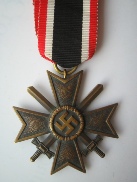 |
| German WW2 Iron Cross First Class brass core |
The history of the Iron Cross goes back to the Kingdom of Prussia as a military decoration. It was established by King Friedrich Wilhelm III of Prussia and first awarded on 10 March 1813 in Breslau, during the Napoleonic Wars. The recommissioned Iron Cross was also awarded during the Franco-Prussian War, the First World War, and the Second World War. The standard Iron cross in WW2 came in the following classes:
Iron Cross 2nd Class
Iron Cross 1st Class
The Iron Cross was awarded for bravery in battle and other acts of heriosm on the battlefield. The 2nd class came with a ribbon coloured black-white-red-white-black. The 1st Class Iron Cross came with no ribbon but was attached either with a pin or a screw fitment (the screw variant being rarer). The 1st Class has a swastika in the centre with the date 1939 below. It is constructed from three pieces.
 |
| Rear of Iron Cross showing pin attachment |
 |
| Closer view of front showing brass core under rubbed black paint |































